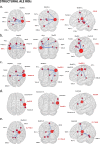An ALE meta-analytic review of musical expertise
- PMID: 35821035
- PMCID: PMC9276732
- DOI: 10.1038/s41598-022-14959-4
An ALE meta-analytic review of musical expertise
Abstract
Through long-term training, music experts acquire complex and specialized sensorimotor skills, which are paralleled by continuous neuro-anatomical and -functional adaptations. The underlying neuroplasticity mechanisms have been extensively explored in decades of research in music, cognitive, and translational neuroscience. However, the absence of a comprehensive review and quantitative meta-analysis prevents the plethora of variegated findings to ultimately converge into a unified picture of the neuroanatomy of musical expertise. Here, we performed a comprehensive neuroimaging meta-analysis of publications investigating neuro-anatomical and -functional differences between musicians (M) and non-musicians (NM). Eighty-four studies were included in the qualitative synthesis. From these, 58 publications were included in coordinate-based meta-analyses using the anatomic/activation likelihood estimation (ALE) method. This comprehensive approach delivers a coherent cortico-subcortical network encompassing sensorimotor and limbic regions bilaterally. Particularly, M exhibited higher volume/activity in auditory, sensorimotor, interoceptive, and limbic brain areas and lower volume/activity in parietal areas as opposed to NM. Notably, we reveal topographical (dis-)similarities between the identified functional and anatomical networks and characterize their link to various cognitive functions by means of meta-analytic connectivity modelling. Overall, we effectively synthesized decades of research in the field and provide a consistent and controversies-free picture of the neuroanatomy of musical expertise.
© 2022. The Author(s).
Conflict of interest statement
The authors declare no competing interests.
Figures



Similar articles
-
Music training is neuroprotective for verbal cognition in focal epilepsy.Brain. 2019 Jul 1;142(7):1973-1987. doi: 10.1093/brain/awz124. Brain. 2019. PMID: 31074775
-
Musical training intensity yields opposite effects on grey matter density in cognitive versus sensorimotor networks.Brain Struct Funct. 2014 Jan;219(1):353-66. doi: 10.1007/s00429-013-0504-z. Epub 2013 Feb 14. Brain Struct Funct. 2014. PMID: 23408267
-
Neural correlates of musical timbre: an ALE meta-analysis of neuroimaging data.Front Neurosci. 2024 Jun 17;18:1373232. doi: 10.3389/fnins.2024.1373232. eCollection 2024. Front Neurosci. 2024. PMID: 38952924 Free PMC article.
-
How Musical Training Shapes the Adult Brain: Predispositions and Neuroplasticity.Front Neurosci. 2021 Mar 10;15:630829. doi: 10.3389/fnins.2021.630829. eCollection 2021. Front Neurosci. 2021. PMID: 33776638 Free PMC article. Review.
-
Exploring the functional neuroanatomy of music performance, perception, and comprehension.Ann N Y Acad Sci. 2001 Jun;930:211-31. doi: 10.1111/j.1749-6632.2001.tb05735.x. Ann N Y Acad Sci. 2001. PMID: 11458831 Review.
Cited by
-
Audiovisual integration in the McGurk effect is impervious to music training.Sci Rep. 2024 Feb 8;14(1):3262. doi: 10.1038/s41598-024-53593-0. Sci Rep. 2024. PMID: 38332159 Free PMC article.
-
The brain on expert medical performance: a systematic review and activation likelihood estimation functional magentic resonance imaging meta-analysis.Psychoradiology. 2025 Jul 7;5:kkaf019. doi: 10.1093/psyrad/kkaf019. eCollection 2025. Psychoradiology. 2025. PMID: 40697627 Free PMC article. Review.
-
Moderate associations between BDNF Val66Met gene polymorphism, musical expertise, and mismatch negativity.Heliyon. 2023 Apr 18;9(5):e15600. doi: 10.1016/j.heliyon.2023.e15600. eCollection 2023 May. Heliyon. 2023. PMID: 37153429 Free PMC article.
-
Polygenic Associations between Motor Behaviour, Neuromotor Traits, and Active Music Engagement in Four Cohorts.bioRxiv [Preprint]. 2025 Mar 30:2025.03.27.645667. doi: 10.1101/2025.03.27.645667. bioRxiv. 2025. PMID: 40196524 Free PMC article. Preprint.
-
Music reward sensitivity is associated with greater information transfer capacity within dorsal and motor white matter networks in musicians.Brain Struct Funct. 2024 Dec;229(9):2299-2313. doi: 10.1007/s00429-024-02836-x. Epub 2024 Jul 25. Brain Struct Funct. 2024. PMID: 39052097 Free PMC article.
References
Publication types
MeSH terms
LinkOut - more resources
Full Text Sources

